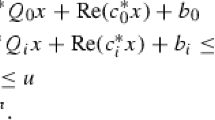Abstract
We study an extended trust region subproblem minimizing a nonconvex function over the hollow ball \(r \le \Vert x\Vert \le R\) intersected with a full-dimensional second order cone (SOC) constraint of the form \(\Vert x - c\Vert \le b^T x - a\). In particular, we present a class of valid cuts that improve existing semidefinite programming (SDP) relaxations and are separable in polynomial time. We connect our cuts to the literature on the optimal power flow (OPF) problem by demonstrating that previously derived cuts capturing a convex hull important for OPF are actually just special cases of our cuts. In addition, we apply our methodology to derive a new class of closed-form, locally valid, SOC cuts for nonconvex quadratic programs over the mixed polyhedral-conic set \(\{x \ge 0 : \Vert x \Vert \le 1 \}\). Finally, we show computationally on randomly generated instances that our cuts are effective in further closing the gap of the strongest SDP relaxations in the literature, especially in low dimensions.
Similar content being viewed by others
Notes
This differs from other papers, which often define RLT constraints only for explicitly given valid linear constraints, of which (1) has none. So, for the sake of generality, we have defined the RLT constraints allowing for implicit valid linear constraints.
Indeed, our initial motivation for this paper was the desire to understand the inequalities in [9] more fully.
We provide Matlab code for these manipulations in the file chenetal/verify_chenetal.m at the website https://github.com/A-Eltved/strengthened_sdr.
Indeed, for any closed, convex cone \(\mathcal{K}\) and dual cone \(\mathcal{K}^*\), given \(\hat{x} \in \text {int}(\mathcal{K})\), we claim the truncation \(\mathcal{K}^* \cap \{ s : \hat{x}^T s \le 1 \}\) is bounded. Specifically, its recession cone \(\mathcal{K}^* \cap \{ s : \hat{x}^T s \le 0 \} = \{0\}\). If not, then some nonzero \(\tilde{s} \in \mathcal{K}^*\) satisfies \(\hat{x}^T \tilde{s} \le 0\). Because \(\hat{x}\) is interior, for sufficiently small \(\epsilon > 0\), the point \(\tilde{x} := \hat{x} - \epsilon \tilde{s}\) satisfies \(\tilde{x} \in \mathcal{K}\) and \(\tilde{x}^T \tilde{s} < 0\). However, this contradicts the fact that \(\tilde{s} \in \mathcal{K}^*\).
We refer the reader to our GitHub site (https://github.com/A-Eltved/strengthened_sdr) for the full random-generation procedure.
References
Anstreicher, K.M.: Kronecker product constraints with an application to the two-trust-region subproblem. SIAM J. Optim. 27(1), 368–378 (2017)
Argue, C.J., Kılınç-Karzan, F., Wang, A.L.: Necessary and sufficient conditions for rank-one generated cones. Technical report (2020)
Bienstock, D.: A note on polynomial solvability of the CDT problem. SIAM J. Optim. 26(1), 488–498 (2016)
Burer, S.: On the copositive representation of binary and continuous nonconvex quadratic programs. Math. Program. 120(2, Ser. A), 479–495 (2009)
Burer, S., Anstreicher, K.M.: Second-order-cone constraints for extended trust-region subproblems. SIAM J. Optim. 23(1), 432–451 (2013)
Burer, S., Letchford, A.N.: On nonconvex quadratic programming with box constraints. SIAM J. Optim. 20(2), 1073–1089 (2009)
Burer, S., Yang, B.: The trust region subproblem with non-intersecting linear constraints. Math. Program. 149(1–2, Ser. A), 253–264 (2015)
Celis, M.R., Dennis, J.E., Tapia, R.A.: A trust region strategy for nonlinear equality constrained optimization. In: Numerical Optimization, 1984 (Boulder, Colorado, 1984), pp. 71–82. SIAM, Philadelphia (1985)
Chen, C., Atamtürk, A., Oren, S.S.: A spatial branch-and-cut method for nonconvex QCQP with bounded complex variables. Math. Program. 165(2, Ser. A), 549–577 (2017)
Conn, A.R., Gould, N.I.M., Toint, P.L.: Trust-Region Methods. MPS/SIAM Series on Optimization. SIAM, Philadelphia (2000)
CVX Research, Inc.: CVX: Matlab software for disciplined convex programming, version 2.1. http://cvxr.com/cvx (December 2018)
Eltved, A.: Convex Relaxation Techniques for Nonlinear Optimization. PhD thesis, Technical University of Denmark (2021)
Jiang, R., Li, D.: Second order cone constrained convex relaxations for nonconvex quadratically constrained quadratic programming. J. Global Optim. 75(2), 461–494 (2019)
Lasserre, J.B.: Global optimization with polynomials and the problem of moments. SIAM J. Optim. 11(3):796–817 (2000/01)
Low, S.H.: Convex relaxation of optimal power flow—part I: formulations and equivalence. IEEE Trans. Control Netw. Syst. 1(1), 15–27 (2014)
Low, S.H.: Convex relaxation of optimal power flow—part II: exactness. IEEE Trans. Control Netw. Syst. 1(2), 177–189 (2014)
MOSEK ApS: The MOSEK optimization toolbox for MATLAB manual. Version 9.0.105 (2019)
Sherali, H.D., Adams, W.P.: A reformulation–linearization technique for solving discrete and continuous nonconvex problems. In: Pardalos, P., Birge, J.R., Du, D.Z., Floudas, C.A., Mockus, J., Sherali, H.D., Stavroulakis, G. (eds.) Nonconvex Optimization and Its Applications, vol. 31. Kluwer Academic Publishers, Dordrecht (1999)
Shor, N.Z.: Quadratic optimization problems. Soviet J. Comput. Syst. Sci. 25, 1–11 (1987)
Stern, R.J., Wolkowicz, H.: Indefinite trust region subproblems and nonsymmetric eigenvalue perturbations. SIAM J. Optim. 5(2), 286–313 (1995)
Sturm, J.F., Zhang, S.: On cones of nonnegative quadratic functions. Math. Oper. Res. 28(2), 246–267 (2003)
Ye, Y., Zhang, S.: New results on quadratic minimization. SIAM J. Optim. 14(1), 245–267 (2003)
Acknowledgements
The authors acknowledge the support of their respective universities, which allowed the first author to visit the second author in 2019–20, when this research was initiated. In addition, the authors wish to thank Dan Bienstock for constructive comments as well as two anonymous referees, whose suggestions improved the paper significantly.
Author information
Authors and Affiliations
Additional information
Publisher's Note
Springer Nature remains neutral with regard to jurisdictional claims in published maps and institutional affiliations.
Rights and permissions
About this article
Cite this article
Eltved, A., Burer, S. Strengthened SDP relaxation for an extended trust region subproblem with an application to optimal power flow. Math. Program. 197, 281–306 (2023). https://doi.org/10.1007/s10107-021-01737-9
Received:
Accepted:
Published:
Issue Date:
DOI: https://doi.org/10.1007/s10107-021-01737-9




